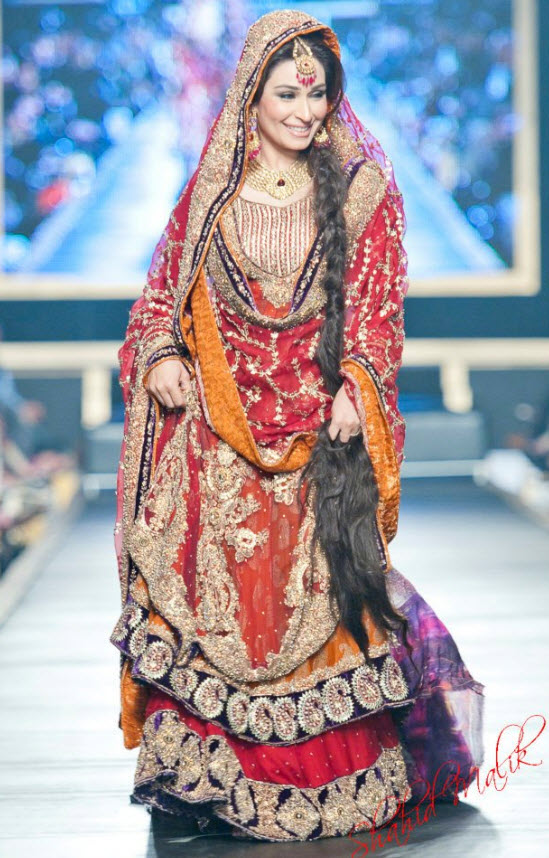Latest Lehnga Design Bridal Biogarphy
Source(google.com.pk)The word 'sari' evolved from the Prakrit word 'sattika' as mentioned in earliest Jain and Buddhist & Hindu literature.
The history of Indian clothing trace the sari back to the Indus Vallery Civilization, which flourished during 2800-1800 BCE around the western part of the Indian Sub-Continent. The earliest known depiction of the saree in the Indian subcontinent is the statue of an Indus valley priest wearing a drape called "Dhooti" (Dhoti).
Ancient Tamil poetry, such as the Silappadhikaram and the Kadambari by BanaBhtta, describes women in exquisite drapery or saree. In ancient Indian tradition and the Natya Shastra (an ancient Indian treatise describing ancient dance and costumes), the Navel of the Supreme Being is considered to be the source of life and creativity, hence the midriff is to be left bare by the saree.
Some costume historians believe that the men's Dhooti, which is the oldest Indian draped garment, is the forerunner of the sari. They say that until the 14th century, the dhoti was worn by both men and women.
Sculptures from the Gandhara, Mathura and Gupta schools (1st-6th century AD) show goddesses and dancers wearing what appears to be a dhoti wrap, in the "fishtail" version which covers the legs loosely and then flows into a long, decorative drape in front of the legs. No bodices are shown.
Other sources say that everyday costume consisted of a dhoti or lungi (sarong), combined with a breast band and a veil or wrap that could be used to cover the upper body or head. The two-piece Kerala Mundum Neryathum (mundu, a dhooti or sarong, neryath, a shawl, in Malayalam is a survival of ancient Indian clothing styles, the one-piece sari is a modern innovation, created by combining the two pieces of the mundum neryathum.
It is generally accepted that wrapped sari-like garments, shawls, and veils have been worn by Indian women for a long time, and that they have been worn in their current form for hundreds of years.
One point of particular controversy is the history of the "Choli", or sari blouse, and the petticoat. Some researchers state that these were unknown before the British arrived in India, and that they were introduced to satisfy Victorian ideas of modesty. Previously, women only wore one draped cloth and casually exposed the upper body and breasts. Other historians point to much textual and artistic evidence for various forms of breastband and upper-body shawl.
Latest Lehnga Design Bridal Wallpaper Photos Pictures Pics Images 2013

Latest Lehnga Design Bridal Wallpaper Photos Pictures Pics Images 2013
Latest Lehnga Design Bridal Wallpaper Photos Pictures Pics Images 2013

Latest Lehnga Design Bridal Wallpaper Photos Pictures Pics Images 2013

Latest Lehnga Design Bridal Wallpaper Photos Pictures Pics Images 2013

Latest Lehnga Design Bridal Wallpaper Photos Pictures Pics Images 2013
Latest Lehnga Design Bridal Wallpaper Photos Pictures Pics Images 2013
.jpg)
Latest Lehnga Design Bridal Wallpaper Photos Pictures Pics Images 2013

Latest Lehnga Design Bridal Wallpaper Photos Pictures Pics Images 2013

Latest Lehnga Design Bridal Wallpaper Photos Pictures Pics Images 2013

Latest Lehnga Design Bridal Wallpaper Photos Pictures Pics Images 2013
No comments:
Post a Comment